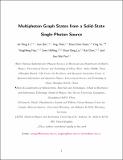Files in this item
Multiphoton graph states from a solid-state single-photon source
Item metadata
| dc.contributor.author | Li, Jin-Peng | |
| dc.contributor.author | Qin, Jian | |
| dc.contributor.author | Chen, Ang | |
| dc.contributor.author | Duan, Zhao-Chen | |
| dc.contributor.author | Yu, Ying | |
| dc.contributor.author | Huo, YongHeng | |
| dc.contributor.author | Hoefling, Sven | |
| dc.contributor.author | Lu, Chao-Yang | |
| dc.contributor.author | Chen, Kai | |
| dc.contributor.author | Pan, Jian-Wei | |
| dc.date.accessioned | 2021-06-04T23:45:29Z | |
| dc.date.available | 2021-06-04T23:45:29Z | |
| dc.date.issued | 2020-07-15 | |
| dc.identifier | 269484908 | |
| dc.identifier | 883c056c-67e8-4c24-889c-0383c0aa0642 | |
| dc.identifier | 000551497000003 | |
| dc.identifier | 85089140482 | |
| dc.identifier.citation | Li , J-P , Qin , J , Chen , A , Duan , Z-C , Yu , Y , Huo , Y , Hoefling , S , Lu , C-Y , Chen , K & Pan , J-W 2020 , ' Multiphoton graph states from a solid-state single-photon source ' , ACS Photonics , vol. 7 , no. 7 , pp. 1603-1610 . https://doi.org/10.1021/acsphotonics.0c00192 | en |
| dc.identifier.issn | 2330-4022 | |
| dc.identifier.uri | https://hdl.handle.net/10023/23313 | |
| dc.description | This work was supported by the National Natural Science Foundation of China (Grants No. 11575174, No. 11674308, No. 11704424, and No. 11774326), the Chinese Academy of Sciences, and the National Key Research and Development Program of China. | en |
| dc.description.abstract | Photonic graph states are underlying resources for one-way optical quantum computation, quantum error correction, fundamental testing of quantum mechanics, and quantum communication networks. Most existing works, however, are based on the spontaneous parametric down-conversion sources that intrinsically suffer from probabilistic generation and double pair components. Here, we create two important classes of graph states, a polarization-encoded four-photon Greenberger–Horne–Zeilinger (GHZ) state and a linear cluster state, by actively demultiplexing a deterministic single-photon source from a semiconductor quantum dot embedded in a micropillar. A state fidelity of 0.790 ± 0.009 (0.763 ± 0.004) and a count rate of ∼13 Hz are observed for the four-photon GHZ (cluster) state. The results constitute a new route toward the multiphoton entanglement with deterministic single-photon sources. | |
| dc.format.extent | 8 | |
| dc.format.extent | 2008400 | |
| dc.language.iso | eng | |
| dc.relation.ispartof | ACS Photonics | en |
| dc.subject | Multiphoton entanglement graph states | en |
| dc.subject | Four-photon GHZ state | en |
| dc.subject | Four-photon linear cluster state | en |
| dc.subject | One-way quantum computation | en |
| dc.subject | Solid-state single-photon source | en |
| dc.subject | Semiconductor quantum dot | en |
| dc.subject | QC Physics | en |
| dc.subject | NDAS | en |
| dc.subject.lcc | QC | en |
| dc.title | Multiphoton graph states from a solid-state single-photon source | en |
| dc.type | Journal article | en |
| dc.contributor.institution | University of St Andrews. School of Physics and Astronomy | en |
| dc.contributor.institution | University of St Andrews. Condensed Matter Physics | en |
| dc.identifier.doi | 10.1021/acsphotonics.0c00192 | |
| dc.description.status | Peer reviewed | en |
| dc.date.embargoedUntil | 2021-06-05 |
This item appears in the following Collection(s)
Items in the St Andrews Research Repository are protected by copyright, with all rights reserved, unless otherwise indicated.

